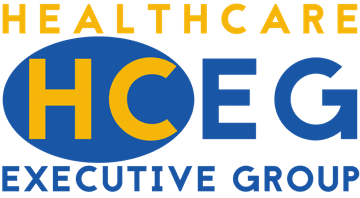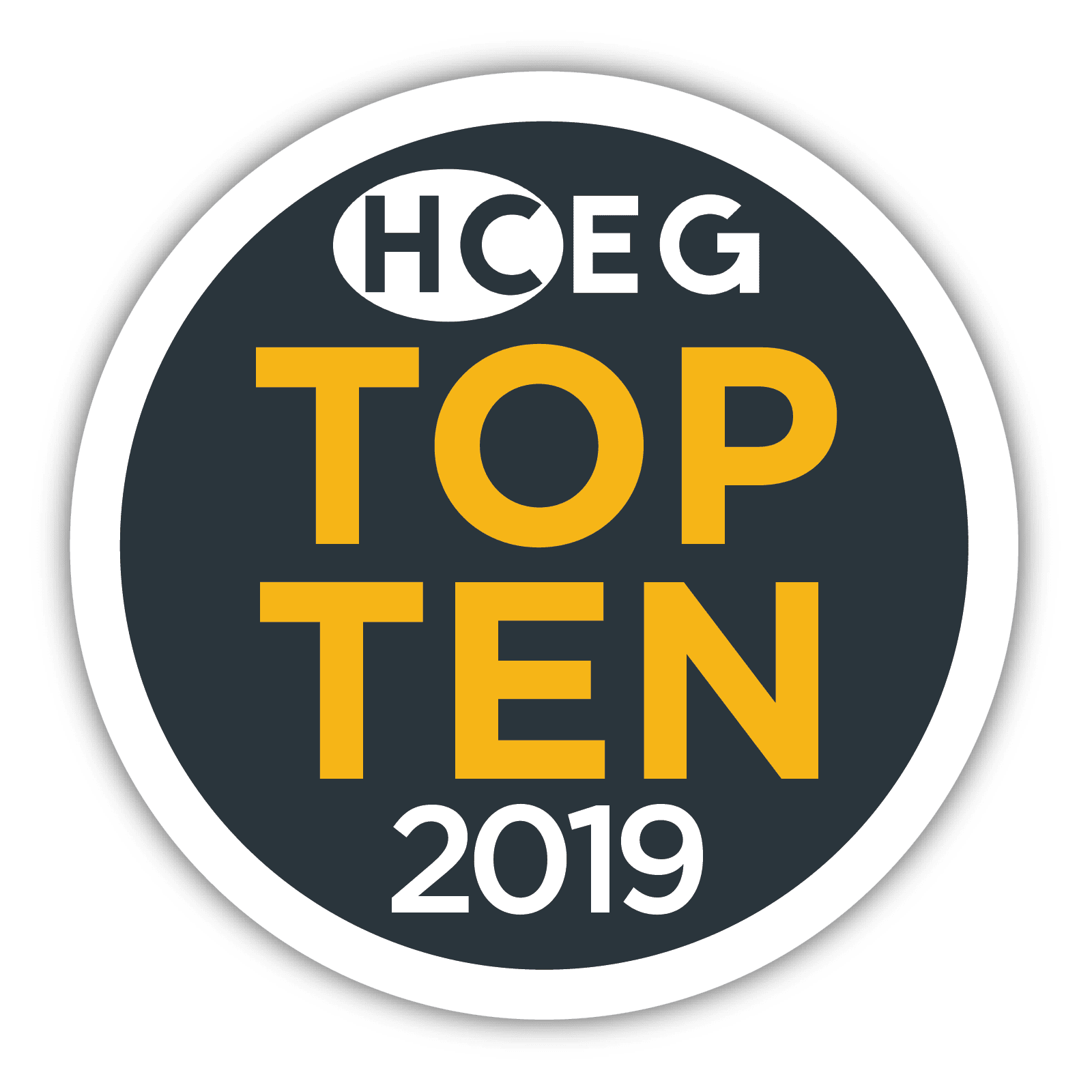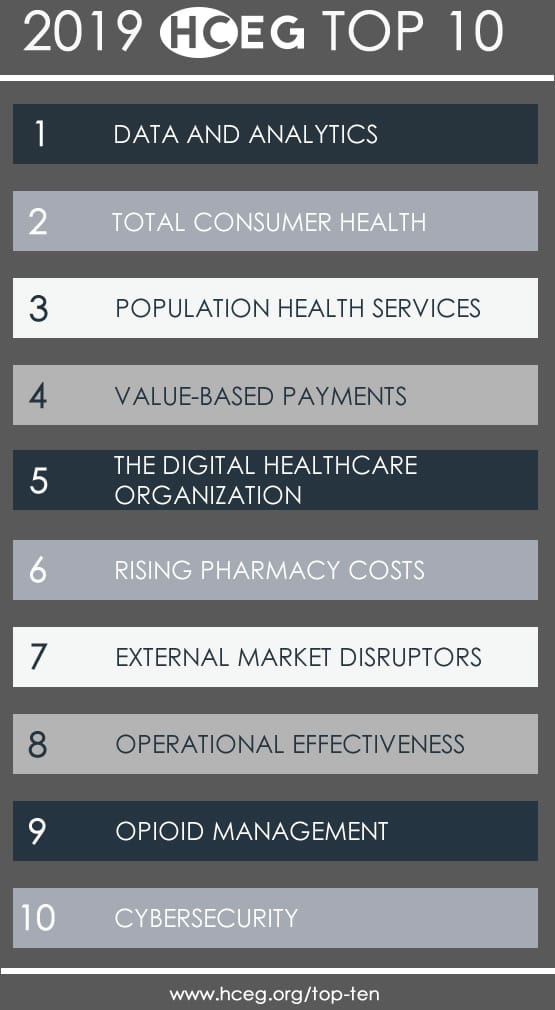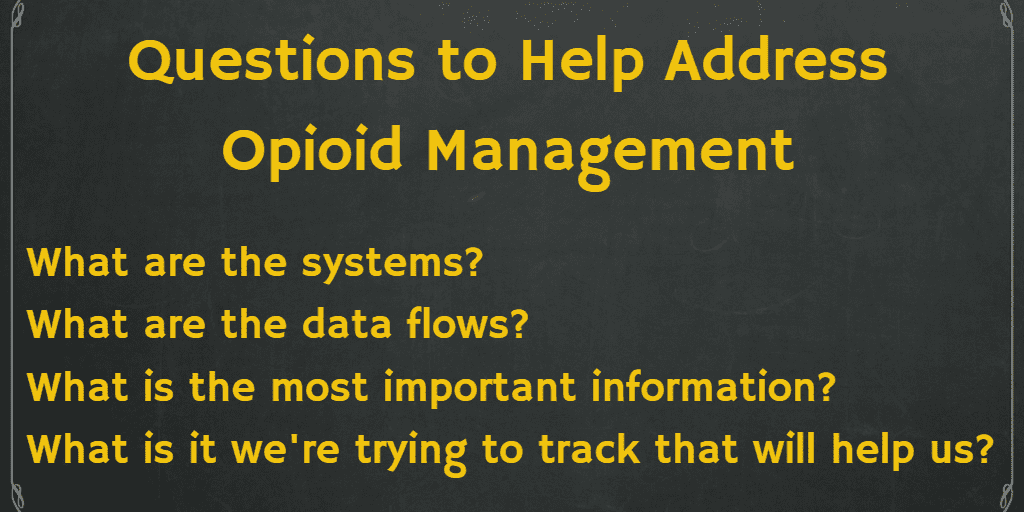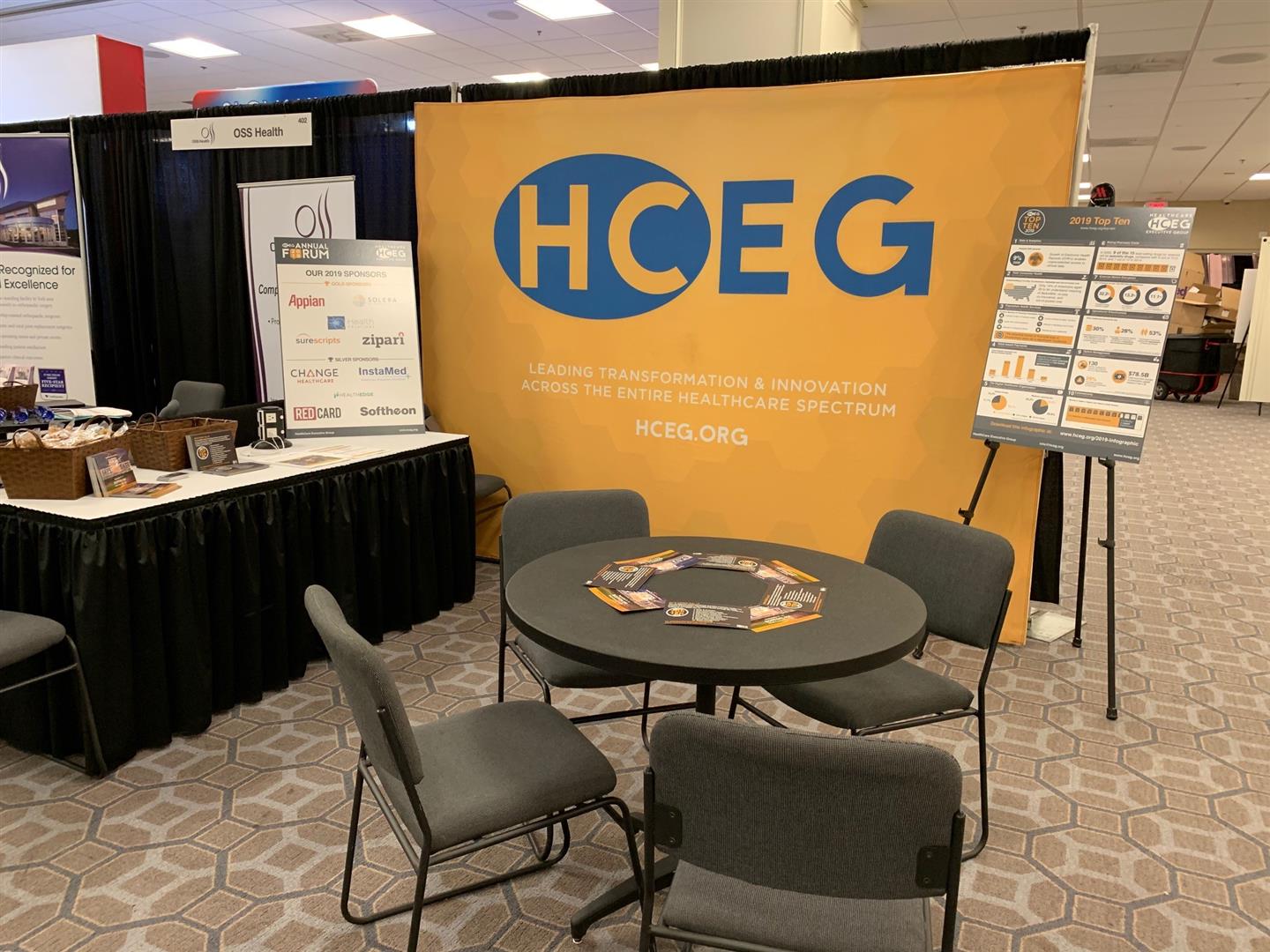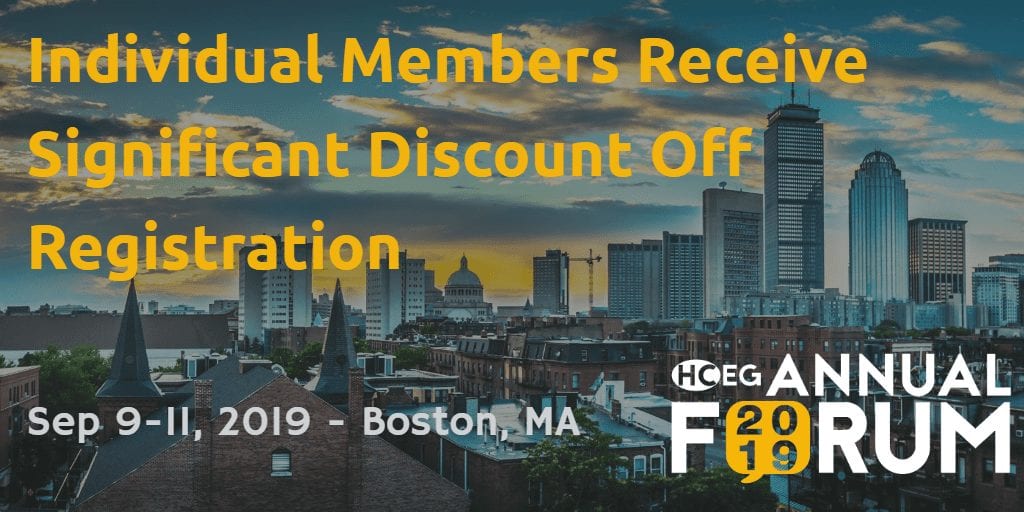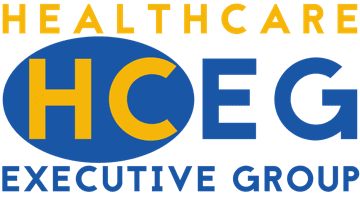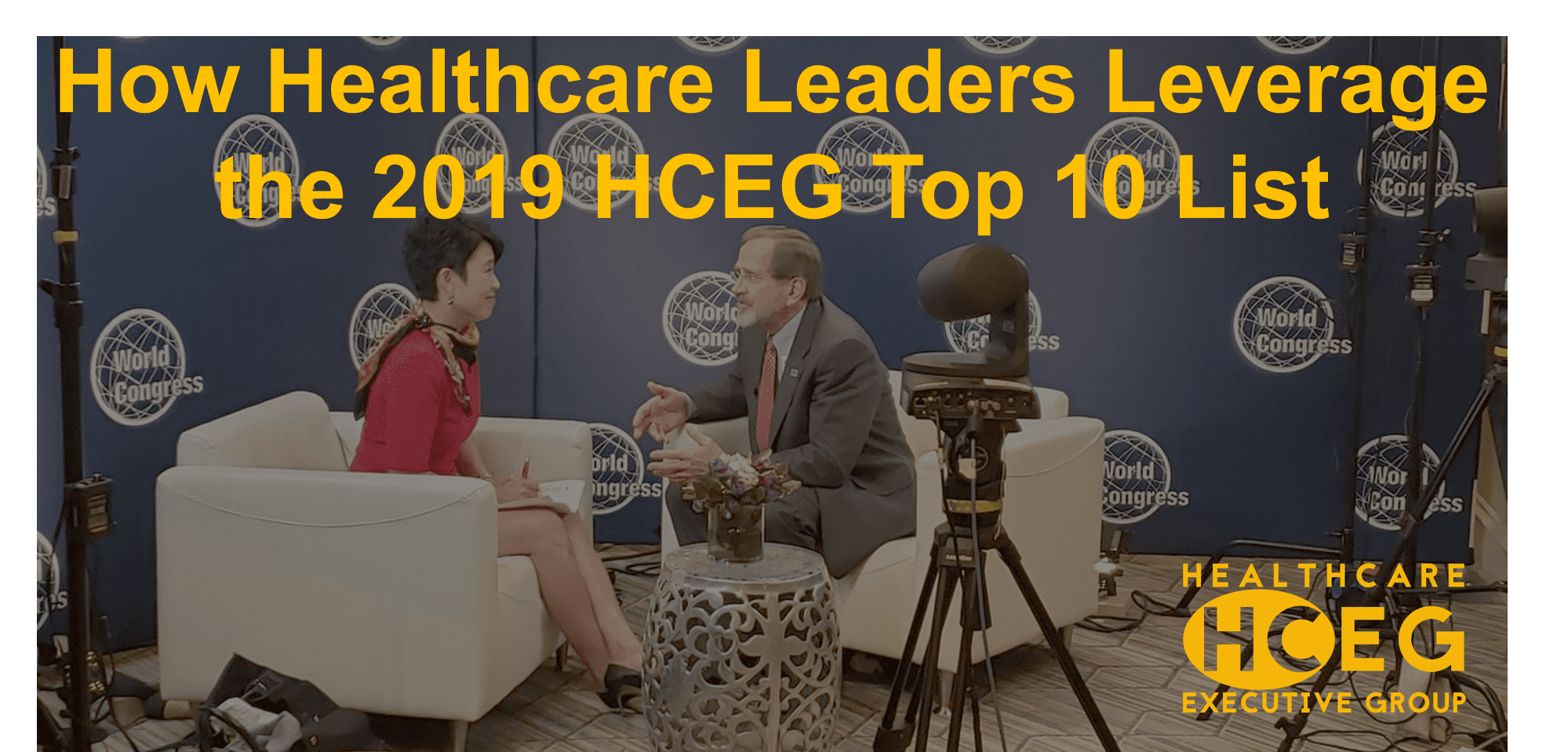
How has the HealthCare Executive Group’s annual Top 10 list of challenges, issues, and opportunities helped to guide healthcare leaders and their companies over the last decade?
During a break at the 16th Annual World Healthcare Congress held in Washington, DC earlier this month, our Executive Director Ferris Taylor had a chance to talk with Mabel Jong of MJC Communications, LLC. Ferris recounted the story of how members of the HealthCare Executive Group have developed and used our annual ‘Top 10’ list of challenges, issues, and opportunities as a means of to verify, validate, and address their top challenges, issues, and opportunities.
The following is a verbatim transcript of that interview – with a few links and supporting information added in for clarity. You can watch the actual recording here and sign up to receive our eNewsletter here.
Talking About the 2019 HCEG Top 10 List at World Health Care Congress
Mabel Jong: And welcome back. I’m Mabel Jong and you’re watching live coverage of the World Health Care Congress on WHCCTV. Thank you so much for joining us.
We’re going to learn a little bit about the HealthCare Executive Group. Their executive director Ferris Taylor is here.
Ferris Taylor: Well thank you Mabel, it’s good to be with you.
I understand you’re from Boston where the HealthCare Executive Group started in 1988 in Maynard, Massachusetts when a mini computer manufacturer disbanded their healthcare user’s group. That group of users said: “Forget about Digital Equipment, we find value in networking, being able to share the challenges and the opportunities of healthcare” To have somebody around the country that I can pick up the phone and call and say: “Hey, I’m having this problem.”
And if my colleague in Minneapolis says: “I’m not having that problem,” then maybe there’s something wrong with me. Or maybe, we have something to talk about. Or if we both have that problem, then how are we solving that?
So, it’s a small network 100 members or so, primarily technology leaders in their organizations, payers, and providers that find personal, professional and organizational value in sharing ideas about how to address the challenges in healthcare. And as you know, we have lots of lots of them.
Mabel: Lots of them. And in terms of sharing ideas, you also have done a lot of research on coming up with a top 10 list. Not David Letterman’s top 10 list but…
Ferris: It started out that way.
Mabel: Okay. Share with me what this list is about and who makes it.
RELATED: Recapping 16th Annual World Health Care Congress & CIO/CTO Strategy Track
Healthcare Leaders Identify Issues, Challenges, & Opportunities
Ferris: And it’s fascinating because from the very beginning there was always a conversation about the challenges in healthcare. And 10 or 15 years ago the CIO at Health Partners,
Alan Abramson said: “You know, when I go home from our meetings, my executives asked me what we’d been talking about and I tell them.”
But there would be value if we actually went through a process and shared with the industry what our members see as the challenges in the foreseeable future in health care.
So about 15 years ago we started publishing, and at the time it really was (based on) the David Letterman (Top 10 list). We keyed on that – ‘here’s our top ten list.’ And it’s evolved from that. Our members at the end of the year actually vote from a list of 30 or 40 issues that we talked about in the year – what their top 10 issues are. And then we go through a process of ranking them and it (HCEG’s Top 10 list) becomes the benchmark that our members use.
And I recommend that other companies, other healthcare stakeholders around the industry use the Top 10 list to ask themselves: “Am I addressing these issues? Are they on my priority list? What’s my action plan with respect to those issues?”
Mabel: Okay. So, does it go from most important to…
Ferris: We do rank them.
Mabel: Okay. So, number one, you have Data and Analytics all the way to number 10 cybersecurity.
Ferris: That’s a big range.
Mabel: That is a big range. So, people are saying these are the issues that we’re currently facing and that we’re concerned about.
Something Old, And Something New on the 2019 HCEG Top 10 List
Ferris: Exactly. And another dimension of this that you don’t see but is very important is that I can look back over time and see how those issues have moved around. Up until 2015, cybersecurity wasn’t on our list. And then you have two major health plans – 80-million-member record breach, 20-million-member record reach. So a 100 million members records have been lost to the dark side.
Mabel: So, it made the list.
Ferris: Right. And the fact that it’s number 10 doesn’t mean that it’s not important but other things have become more important. Number four is Value-Based Reimbursement. And World Healthcare Congress this week has talked a lot about value and clinical appropriateness of price and those issues.
Three years ago, value-based reimbursement was number one on our list. You could say: “Well it’s dropped in importance.” But in fact, if I look back over our conversations – and we have monthly webinars and do a lot of blogging and then we have quarterly executive roundtables where we take these issues and discuss them in our annual meeting, we spend a hold three days on the program. The discussion was: we can’t get to value-based payments until we have a better handle on data, and in particular, clinical data. We’ve got a lot of claims data but we need the clinical data and we need agreement on the majors and the outcomes and the data we’re going to track before we can get to value-based reimbursement.
RELATED: The 2019 HCEG Top 10 List of Healthcare Challenges, Issues & Opportunities
Of Course, Social Determinants of Health Are On the List
Ferris: We need to bring the consumer in. Number two is Total Consumer Health. Number three is labeled Population Health Services. We call it social determinants of health but it’s really the barriers to medical health that are non-medical. And we’ve narrowly defined healthcare as medical and it isn’t.
Mabel: Well also, at number nine is Opioid Management.
Ferris: And that’s a new one this year.
Mabel: Yes. I can imagine it would be.
Ferris: Right
Mabel: But it’s a crisis and your executives are very concerned about this.
Ferris: They are. And on all of these issues. They’re corporate issues. In our discussions, many times they’ve evolved to: What are the systems? What are the data flows? What is the information? What is it that we’re trying to track that will help us, help our executive team address or better handle a crisis like opioid management?
Using the 2019 HCEG Top 10 List to Define and Frame Problems
And you know, from a technology point of view, you could say: “Well that’s a medical issue, it’s not a technology issue.” But, in fact, in our data for a number of years, there were indicators that this was becoming a problem and we didn’t analyze it.
Mabel: I see. Okay. So now that executives have outlined these as their concerns, what does your group do about that?
Ferris: Well, we’re very action-oriented. But to get to action you’ve got to be very sure you define the problem correctly and have the components of the solution in place before you take action. And so, a lot of what we’re focused on are, as a group, here’s what I’m doing from a system and a technology point of view to address each one of these issues.
And their colleague in another part of the country, somebody that they don’t compete against. So they can be very open and sharing are saying: “Well you know, in addition to that I’m doing this.” And the colleague may respond: “Oh, I hadn’t thought about that. I need to bring that to the table as well.” And then they can go to their management team in a very organized and comfortable way saying: “This isn’t just my idea. This is what a group of our colleagues that are similar to us is doing.”
RELATED: 2019 HCEG Top 10 Infographic
A Common Frame of Reference For Healthcare Leadership
And it gets better acceptance. It allows these things to become priorities within each company’s competitive marketplace because everybody’s different with their resources with the focus that they have on health care.
If you’re a Medicaid plan you have a different focus than if you’re a Medicare, commercial or a dual-eligible plan. So, it’s the networking that leads to the actions that can take place here.
Our closing session yesterday here at World Health Care Congress was two of our board members. Board chair Kim Sinclair from Boston Children’s Medical Center and Alan Abramson from Health Partners sharing with everybody here at World Healthcare Congress what they see out of these as their priority. And going into specifics: these are the things that we are doing to address the challenges that we’ve already acknowledged.
Mabel: All right. Ferris, thank you so much for sharing your experience with HCEG. We appreciate it.
Ferris: It’s a lot of fun all right.
Mabel: Thank you for joining us stay tuned we’re rounding out our last interview very shortly.
Join Other Healthcare Leaders to Digitally Transform Your Organization
For more information, insight, and ideas about the challenges, issues, and opportunities facing healthcare leadership during these uncertain times, consider these opportunities:
- Subscribe to our eNewsletter
- Follow @HCExecGroup on Twitter
- Join us on LinkedIn
- Become an Individual Member of the HealthCare Executive Group – Use KickOffPromo here for a special, limited time $50 discount
- Join us in Boston, Massachusetts for 2019 Annual Forum on September 9th-11th, 2019
If you have any questions or comments, please contact us
